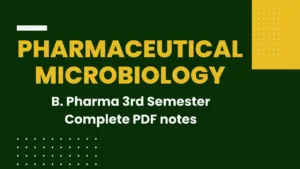Pharmaceutical Microbiology – B. Pharma 3rd Semester Complete PDF notes

Scope: Study of all categories of microorganisims especially for the production of alchol antibiotics, vaccines, vitamins enzymes etc..
Objectives: Upon completion of the subject student shall be able to;
1. Understand methods of identification, cultivation and preservation of various microorganisms
2. To understand the importance and implementation of sterlization in pharmaceutical processing and industry
3. Learn sterility testing of pharmaceutical products.
4. Carried out microbiological standardization of Pharmaceuticals.
5. Understand the cell culture technology and its applications in pharmaceutical industries.
Pharmaceutical Microbiology Course content:
Pharmaceutical Microbiology Unit I
Introduction, history of microbiology, its branches, scope and its importance.
Introduction to Prokaryotes and Eukaryotes
Classification of Microorganism,
Nutritional Requirement of Microorganisms
Environmental Factor affecting microbial growth.
Biochemical reaction in identification of microorganism.
Growth curve,
Quantitative measurement of bacterial growth (total & viable count).
Study of different types of phase constrast microscopy, dark field microscopy and electron microscopy.
Pharmaceutical Microbiology Unit II
Concept of Sterilization and Sterilization Methods.
Study of principle, procedure, merits, demerits and applications of Dry Heat Sterilization,
Chemical Gaseous Sterilization,
Pasteurization and Tyndallization.
Evaluation of the efficiency of sterilization methods.
Equipments employed in large scale sterilization.
Sterility indicators.
Pharmaceutical Microbiology Unit III
Study of morphology, classification, reproduction/replication and cultivation of Fungi.
Study of morphology, classification and cultivation of Viruses.
Study of morphology, classification, reproduction/replication and cultivation of Bacteria.
Disinfectants
Classification and mode of action of disinfectants
Determination of virucidal activity of disinfectants
Evaluation of bactericidal & Bacteriostatic.
Unit IV
Principles and methods of different microbiological assay – General Method.
Methods for standardization of antibiotics, vitamins and amino acids.
Assessment of a new antibiotic.
Pharmaceutical Microbiology Unit V
Application of cell cultures in pharmaceutical industry and research.
Frequently Asked Questions (FAQs)
1. What is Pharmaceutical Microbiology? Pharmaceutical Microbiology is a branch of microbiology that specifically deals with the study of microorganisms and their activities in the pharmaceutical industry. It involves the control and prevention of microbial contamination in pharmaceutical products and processes.
2. Why is Microbial Control Important in the Pharmaceutical Industry? Microbial control is crucial in the pharmaceutical industry to ensure the safety, efficacy, and quality of pharmaceutical products. Microbial contamination can lead to product spoilage, reduced shelf life, and pose a risk to patient health.
3. What are the Common Sources of Microbial Contamination in Pharmaceuticals? Common sources of microbial contamination include air, water, raw materials, equipment, personnel, and the manufacturing environment. Contamination can occur at any stage of the pharmaceutical production process.
4. What are the Regulatory Guidelines for Microbial Control in Pharmaceuticals? Regulatory agencies such as the FDA and EMA provide guidelines to ensure microbial control in pharmaceuticals. These guidelines include Good Manufacturing Practices (GMP) and specific requirements for microbial monitoring, testing, and validation.
5. What are the Key Microorganisms of Concern in Pharmaceutical Microbiology? Common microorganisms of concern include bacteria, viruses, fungi, and endotoxins. Specific strains and species that may be pathogenic or cause product degradation are closely monitored.
6. How is Sterility Assurance Achieved in Pharmaceutical Manufacturing? Sterility assurance is achieved through aseptic processing, where sterile products are manufactured in a controlled and sterile environment. This involves the use of sterile equipment, cleanrooms, and strict procedures to prevent microbial contamination.
7. What is the Purpose of Environmental Monitoring in Pharmaceutical Microbiology? Environmental monitoring involves the regular testing of air, surfaces, and personnel for microbial contamination within the manufacturing environment. This helps to identify and control potential sources of contamination.
8. How are Antimicrobial Agents Tested for Effectiveness in Pharmaceuticals? Antimicrobial effectiveness is tested through methods such as microbial challenge testing and preservative efficacy testing. These tests ensure that pharmaceutical products containing antimicrobial agents remain effective throughout their shelf life.
9. What is the Role of Microbial Limit Testing in Pharmaceutical Quality Control? Microbial limit testing is performed to determine the total viable microbial count in pharmaceutical products. It helps ensure that the microbial content is within acceptable limits as per regulatory standards.
10. How are Microbial Contaminations Handled in the Event of a Recall? In the event of a microbial contamination leading to a product recall, pharmaceutical companies must follow established procedures to identify the source of contamination, implement corrective actions, and prevent future occurrences. Communication with regulatory authorities and the public is also a critical aspect.
PHARMACEUTICAL MICROBIOLOGY (Practical)
PHARMACEUTICAL MICROBIOLOGY (Practical) Lab Manual
Also, Visit: B. Pharmacy Notes | B. Pharma Notes | Study material Bachelor of Pharmacy
